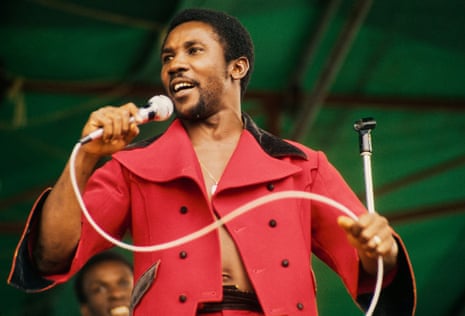Bob Marley and the Wailers were the band who transformed reggae from a cult phenomenon outside of its homeland. But it was the Wailers’ rivals, Toots and the Maytals – another vocal trio that expanded to a full band – who were, at least initially, thought most likely to cross over.
And why not? The Maytals had cut a swathe through Jamaican music in the 1960s and early 70s, releasing a succession of fantastic singles – Sweet and Dandy, Pressure Drop, Monkey Man, 54-46 That’s My Number (later re-recorded as 54-46 Was My Number) and more – that had made them the country’s biggest band. They had effectively named the genre they worked in with 1968’s Do the Reggae. They had two songs on the soundtrack of The Harder They Come, the first reggae album to make commercial inroads in the US, and a great album of their own, Funky Kingston, in 1972. If Bob Marley stole their thunder, and he undoubtedly did, then it was as much about canny marketing as it was about the standard of their music – the way Island Records boss Chris Blackwell sweetened the Wailers’ sound with British and American session musicians, or packaged Catch a Fire (1973) more like a progressive rock album than a product of Kingston.
Toots and the Maytals started life as the Vikings, with some of the singles they made after changing their name to the Maytals released as the Vikings or the Flames; their frontman-boosting shift in the late 60s to Toots and the Maytals was pre-empted by the fact that they’d already randomly deployed that name since 1965.
What never varied was the quality of their releases: tight harmonies and Hibbert’s powerful lead, both of which increasingly demonstrated the influence of American R&B. While the Wailers’ American guiding light was Curtis Mayfield and the Impressions, the Maytals seemed to be looking further south. There was a distinct hint of gospel about the harmonies, while, in a certain light, Hibbert’s voice seemed not unlike that of Otis Redding.
Their writing developed as the rhythms of ska slackened. In 1965, they released Bam Bam, a song that became one of the cornerstones of reggae, covered umpteen times over the ensuing decades, impervious to changing styles and tastes: the melody of its chorus has subsequently turned up everywhere from Lauryn Hill’s Lost Ones to Kanye West’s Famous. The 1982 version by Sister Nancy that interpolated it with Ansell Collins’ instrumental single Stalag 17 may well be the most-sampled reggae track in history.
Hibbert’s arrest for marijuana possession in 1966 should have derailed their career. Instead, his time in prison inspired another classic song, 54-46 (That’s My Number), part of material recorded with producer Leslie Kong between 1967 and 1970 that included most of their best-known songs. The appearance of Monkey Man – aimed at a love rival – in the lower reaches of the UK chart was the first sign of interest outside Jamaica.
But the UK charts were liberally peppered with Jamaican singles in 1970, the preferred soundtrack of youth culture’s folk devils, the skinheads: its association with the movement was a barrier to reggae’s wider acceptance in Britain. The Funky Kingston album was good enough to break through – the title track is particularly magnificent; Love Is Going to Let Me Down a perfect demonstration of Hibbert’s soulfulness – but it sounded rough-hewn compared to the Wailers’ Catch a Fire, at least after Blackwell had finished with the latter. It was the more authentic document of what reggae sounded like, but perhaps it was too close to music associated with boots and braces and cropped hair to have the same commercial impact.
To his credit, Blackwell kept trying to replicate the Wailers’ success with the Maytals, releasing a revamped version of the album in the US, replacing a number of tracks with songs from its equally great follow-up, 1974’s In the Dark, including the fantastic Time Tough and a lovely cover of John Denver’s Take Me Home, Country Roads. He also sent them out on tour with the Who. But an audience who’d paid to hear Pinball Wizard and My Generation proved uninterested and the Maytals’ subsequent albums, Reggae Got Soul (1976) and Pass the Pipe (1979), were less inspired, lacking the fervent edge of the greatest roots albums of the late 70s: the Congos’ Heart of the Congos, say, and Culture’s Two Sevens Clash.
The arrival of punk and Two Tone meant more exposure for the Maytals’ earlier material – the Clash covered Pressure Drop, the Specials did Monkey Man – while Jamaica seemed to remain under its spell: quite aside from the umpteen takes on Bam Bam, the title track of dancehall star Yellowman’s 1984 album Nobody Move was based on 54-46 (That’s My Number).
It meant that Hibbert never wanted for live work, even after the Maytals disbanded and his recording career slowed down following 1981’s Knockout, an album on which the excursions into disco (Will You Be Kind) and straightforward soul (the wonderful Missing You) were more satisfying than the reggae tracks – the latter in particular was enough to make you wish he would try his hand at an album along similar lines. He came closest in 1988 on Toots in Memphis, which made explicit his debt to US soul, Hibbert charging through covers of Hard to Handle and Love and Happiness. Meanwhile, if no reasonable person would pick any of the remakes on the 2004 album True Love over the original versions, at least the celebrity of the guest stars – Eric Clapton, Keith Richards, the Roots, Bootsy Collins and Willie Nelson among them – gives you an idea of the regard Hibbert was held in.
His own latterday material never quite matched the stuff he made in the late 60s and early 70s, though his voice still sounded great on his final album, Got to Be Tough. To find out what the fuss was about in the first place, you have to venture back further: crank up Pressure Drop, or 54-46, or Funky Kingston, and wonder why there was only room for one global Jamaican superstar in the 70s.

